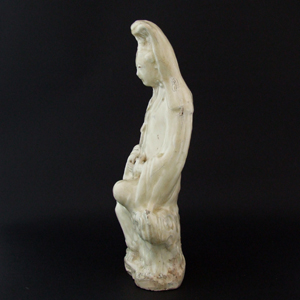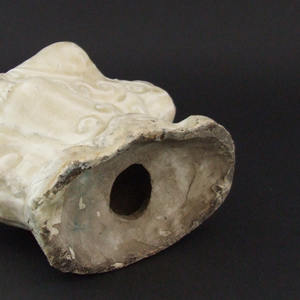
LATE MING or EARLY QING DYNASTY c.1600 – 1700 Cizhou Ware
A Rare Cizhou Model of Guanyin, Late Ming or Early Qing Dynasty 17th Century. This Stoneware Figure Depicts Guanyin Seated on a Rocky Outcrop with One Leg Resting Above the Knee of Her other Leg. She Holds an Elaborate Ruyi-Sceptre in Her Right Hand. Her Eyes Are Highlighted in a Pale Iron-Oxide Brown.
SOLD
- Condition
- In very good condition, two very small glaze losses to the edges of the rocks, a glaze loss associated with some crazing to one shoulder, most likely a firing fault. Some minor staining to the back. Numerous small firing faults.
- Size
- Height : 27.8 cm (11 inches)
- Provenance
- An English Private Collection of Blanc de Chine Porcelain.
- Stock number
- 234101
- References
- A Fahua figure of similar construction and base is at the British Museum, dated to c.1628-1700, is illustrated in : Catalogue of Late Yuan and Ming Ceramic in the British Museum.(Jessica Harrison-Hall.The British Museum Press, 2001. ISBN 0-7141-1488-X.) page 429, item 13:41. For another figure of this type, dated to the 17th century, see ; An Important Collection of Chinese Ceramics, Christie`s London, 12th and 13th of May 1986, lot 61. For two very similar groups of this model from the collection of Robert Henry Benson (1850-1929) see our `Sold Items` numbers 22434 and 22435.
Information
This unusual Cizhou figure, like much later Cizhou ware is difficult to date. Post Yuan pottery of Cizhou type appears rarely in the reference books, not because it is rare but because it is not well understood. The construction of the piece, which presumably is supposed to emulate Blanc de Chine porcelain, is quite close to a number of Fahua figures of Guanyin. The bases appear very similar indeed, see references below. The figure comes from an English collection of Blanc de Chine porcelain and was presumably used as a comparison piece.
Cizhou Ware :
The name Cizhou originated from the ancient area of Cizhou, encompassing a broad arc across China, which was first recorded during the Sui dynasty (581-618). However, the location constantly shifted and though the area of Cizhou is mentioned in the Tang dynasty (618-906) and Five Dynasties (906-960), each referred to an altered location. During the Song, Jin (1125-1234), Yuan (1279-1368), and partly into the Ming dynasties (1368-1644) the kiln areas of Cizhou were primarily concentrated in the northern provinces of Hebei, Henan, and Shaanxi. From the `History` section of our website by Mindy M. McDonald.
Guanyin :
Figures of Guanyin are some of the most commonly encountered images in Chinese figurative art. Guanyin was the Goddess of mercy. Her origins stem from Tibetan Buddhism, she was originally the patron saint of Tibetan Buddhism `Avalokitesvara`. Guanyin is actually the shorter form of the name Guan shi yin, which means “one who observes the voices of the world.” True to her name, Guanyin listens to and understands the worries that plague man`s existence. Because of her mercy and generosity, Guanyin is the most-loved of China`s divinities, the one people turn to for assistance in their everyday lives. Guanyin is specially venerated by those who are hoping to have children or those who are about to set out for sea. Guanyin has been said to have some of the same qualities as the Virgin Mary of Catholic theology, like the Virgin Mary she is sometimes portrayed holding a child in her arms, indeed she was associated with fecundity and given the title `Giver of Sons`. Guanyin is usually portrayed wearing a white cape. In her right hand. On her head is a crown in the style of the Amitabha-buddha, she is normally shown meditating in a seated position. While the worship of Guanyin can be traced back historically to India, she is the star of countless legends and folk tales in China. Guanyin`s home on earth was the Putuo mountains, located on an island on China`s eastern coast to the south of Shanghai. In China, Putuo-shan is one of the most sacred places in Buddhism and the temple dedicated to Guanyin on the mountain is one of the most important pilgrimage site for Buddhists and non-Buddhists alike. Guanyin`s birth is celebrated on the 19th day of February, and her enlightenment is celebrated on the 19th of September. On those days, the pilgrims flock to Putuo mountain.
